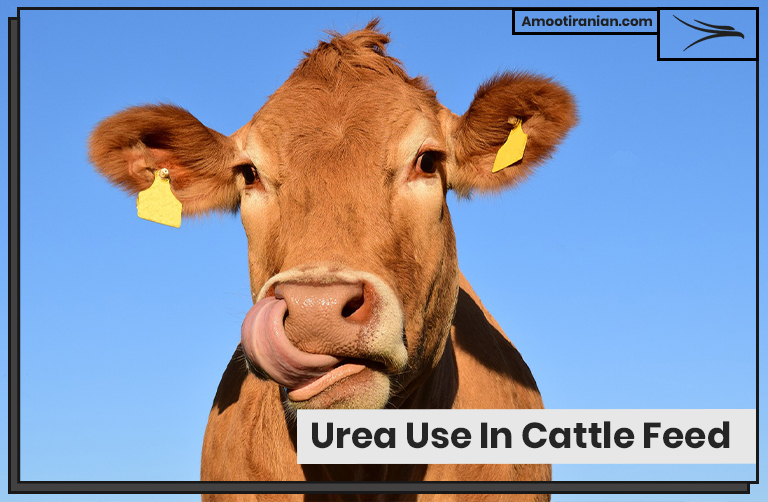.

.
Urea is used in cattle feed as a source of non-protein nitrogen to supplement low-quality forages and stimulate microbial protein synthesis in the rumen.
.
How Do You Add Urea To Animal Feed?
How to mix urea in cattle feed? How Do You Give Urea To Cattle?
Urea can be added to animal feed in different ways, such as:
- top-dressing
- mixing it with other feed ingredients
- dissolving it in water and spraying it onto the feed
.
It’s important to follow recommended guidelines and use appropriate safety measures to avoid over-supplementation and potential harm to the animals.
.
The different ways to add urea to animal feed
| Method | Description |
| Top-dressing | Sprinkling urea directly onto the feed at a rate of 1-2% of the total diet. It’s important to ensure uniform distribution and avoid clumping. This method is suitable for small herds and easy to implement, but requires careful monitoring to avoid over-supplementation and potential harm to the animals. |
| Mixing | Mixing urea with other feed ingredients, such as grains or protein supplements, to ensure even distribution. The recommended inclusion rate is 1-3% of the total diet. This method is commonly used in commercial feed mills and requires specialized equipment to achieve proper mixing. Care should be taken to avoid inhaling dust or fumes during the mixing process. |
| Dissolving | Dissolving urea in water and spraying it onto the feed to improve palatability and ensure even distribution. The recommended inclusion rate is 1-2% of the total diet. This method is commonly used for low-quality forages that are unpalatable or difficult to mix with other ingredients. Care should be taken to avoid splashing or spilling the urea solution, as it can be corrosive and cause skin or eye irritation. |
.
It’s important to note that the inclusion rate of urea should be based on the animal’s dietary requirements and the quality of available forages. Over-supplementation can lead to ammonia toxicity, reduced feed intake, and other health problems.
It’s always best to consult with a veterinarian or animal nutritionist to determine the appropriate amount and method of urea supplementation for a specific herd.
.

.
How Much Urea Can A Cow Eat?
The amount of urea that a cow can eat depends on various factors such as:
- body weight
- production level
- quality of available forages
.
As a general advice, the maximum amount of urea that a cow can safely consume in a day is about 1 gram per kilogram of body weight. This means that a 500 kg cow can consume up to 500 grams (0.5 kg) of urea per day.
However, it’s important to note that over-supplementation of urea can be damaging to the animal’s health, so the actual amount of urea added to the feed should be based on the animal’s specific needs and the quality of available forages.
It’s permanently best to consult with a veterinarian or animal nutritionist to determine the appropriate amount of urea supplementation for a specific herd.
.
What Percentage Of Urea Does Cattle Feed?
The percentage of urea added to cattle feed changes depending on the detailed dietary requirements of the animals and the quality of available forages.
In general, the suggested inclusion rate of urea in cattle feed is between 1% to 3% of the total diet.
.

.
For example, if a cow’s diet has of 10 kg of feed per day, the amount of urea added to the feed would be between 100 grams to 300 grams.
It’s important to note that the inclusion rate of urea should be wisely controlled to avoid over-supplementation, which can be harmful to the animal’s health.
.
What Are The Disadvantages Of Urea In Cattle Feed?
.
While urea can be a valuable source of non-protein nitrogen for cattle feed, there are also some potential disadvantages that should be considered, including:
.
- Toxicity: Over-supplementation of urea can cause ammonia toxicity, which can lead to reduced feed intake, lethargy, convulsions, and even death.
- Palatability: Urea has a bitter taste and can reduce the palatability of feed, which may result in reduced feed intake and lower animal performance.
- Handling: Urea is a caustic substance that can cause skin irritation and respiratory problems if inhaled as dust or fumes. Careful handling and safety precautions are necessary to avoid accidents and injuries.
- Nutrient balance: Urea supplementation must be carefully balanced with other nutrients in the feed to ensure optimal animal performance. Over-reliance on urea as a protein source can lead to imbalances in other nutrients, such as energy and minerals.
- Environmental impact: Excessive urea excretion by animals can contribute to environmental pollution, such as eutrophication of water bodies and air pollution from ammonia emissions.
.

.
Overall, the use of urea in cattle feed requires careful management and monitoring to avoid potential health and environmental problems.
It’s important to consult with a veterinarian or animal nutritionist to determine the appropriate amount and method of urea supplementation for a specific herd.
